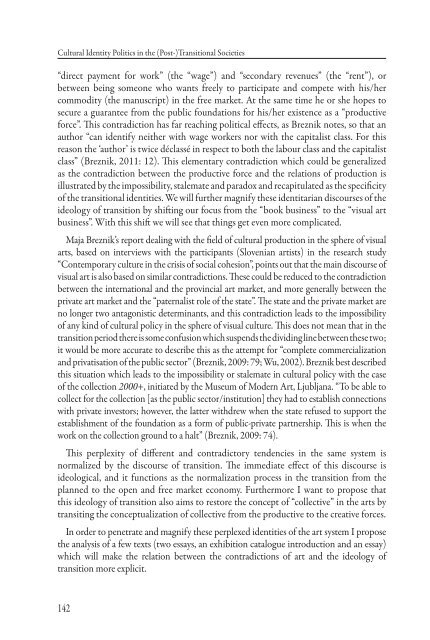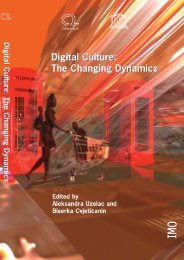free download in pdf format - Culturelink Network
free download in pdf format - Culturelink Network
free download in pdf format - Culturelink Network
You also want an ePaper? Increase the reach of your titles
YUMPU automatically turns print PDFs into web optimized ePapers that Google loves.
Cultural Identity Politics <strong>in</strong> the (Post-)Transitional Societies<br />
“direct payment for work” (the “wage”) and “secondary revenues” (the “rent”), or<br />
between be<strong>in</strong>g someone who wants <strong>free</strong>ly to participate and compete with his/her<br />
commodity (the manuscript) <strong>in</strong> the <strong>free</strong> market. At the same time he or she hopes to<br />
secure a guarantee from the public foundations for his/her existence as a “productive<br />
force”. Th is contradiction has far reach<strong>in</strong>g political eff ects, as Breznik notes, so that an<br />
author “can identify neither with wage workers nor with the capitalist class. For this<br />
reason the ‘author’ is twice déclassé <strong>in</strong> respect to both the labour class and the capitalist<br />
class” (Breznik, 2011: 12). Th is elementary contradiction which could be generalized<br />
as the contradiction between the productive force and the relations of production is<br />
illustrated by the impossibility, stalemate and paradox and recapitulated as the specifi city<br />
of the transitional identities. We will further magnify these identitarian discourses of the<br />
ideology of transition by shift <strong>in</strong>g our focus from the “book bus<strong>in</strong>ess” to the “visual art<br />
bus<strong>in</strong>ess”. With this shift we will see that th<strong>in</strong>gs get even more complicated.<br />
Maja Breznik’s report deal<strong>in</strong>g with the fi eld of cultural production <strong>in</strong> the sphere of visual<br />
arts, based on <strong>in</strong>terviews with the participants (Slovenian artists) <strong>in</strong> the research study<br />
“Contemporary culture <strong>in</strong> the crisis of social cohesion”, po<strong>in</strong>ts out that the ma<strong>in</strong> discourse of<br />
visual art is also based on similar contradictions. Th ese could be reduced to the contradiction<br />
between the <strong>in</strong>ternational and the prov<strong>in</strong>cial art market, and more generally between the<br />
private art market and the “paternalist role of the state”. Th e state and the private market are<br />
no longer two antagonistic determ<strong>in</strong>ants, and this contradiction leads to the impossibility<br />
of any k<strong>in</strong>d of cultural policy <strong>in</strong> the sphere of visual culture. Th is does not mean that <strong>in</strong> the<br />
transition period there is some confusion which suspends the divid<strong>in</strong>g l<strong>in</strong>e between these two;<br />
it would be more accurate to describe this as the attempt for “complete commercialization<br />
and privatisation of the public sector” (Breznik, 2009: 79; Wu, 2002). Breznik best described<br />
this situation which leads to the impossibility or stalemate <strong>in</strong> cultural policy with the case<br />
of the collection 2000+, <strong>in</strong>itiated by the Museum of Modern Art, Ljubljana. “To be able to<br />
collect for the collection [as the public sector/<strong>in</strong>stitution] they had to establish connections<br />
with private <strong>in</strong>vestors; however, the latter withdrew when the state refused to support the<br />
establishment of the foundation as a form of public-private partnership. Th is is when the<br />
work on the collection ground to a halt” (Breznik, 2009: 74).<br />
Th is perplexity of diff erent and contradictory tendencies <strong>in</strong> the same system is<br />
normalized by the discourse of transition. Th e immediate eff ect of this discourse is<br />
ideological, and it functions as the normalization process <strong>in</strong> the transition from the<br />
planned to the open and <strong>free</strong> market economy. Furthermore I want to propose that<br />
this ideology of transition also aims to restore the concept of “collective” <strong>in</strong> the arts by<br />
transit<strong>in</strong>g the conceptualization of collective from the productive to the creative forces.<br />
In order to penetrate and magnify these perplexed identities of the art system I propose<br />
the analysis of a few texts (two essays, an exhibition catalogue <strong>in</strong>troduction and an essay)<br />
which will make the relation between the contradictions of art and the ideology of<br />
transition more explicit.<br />
142



